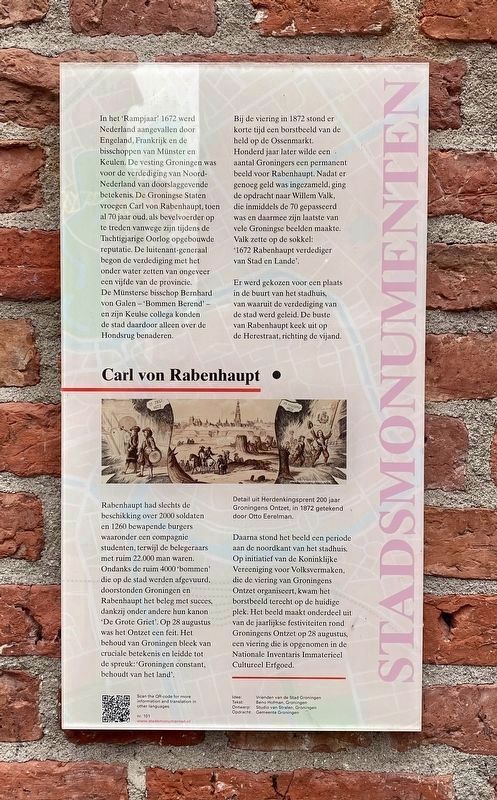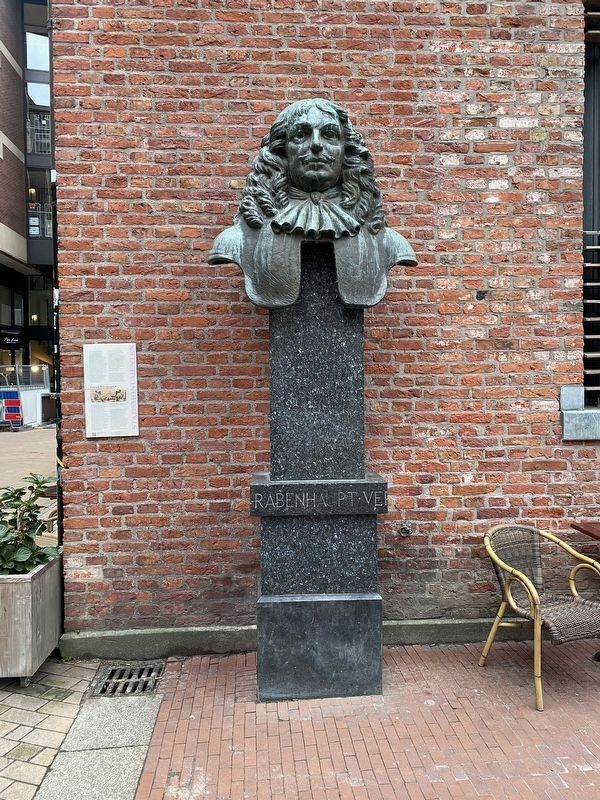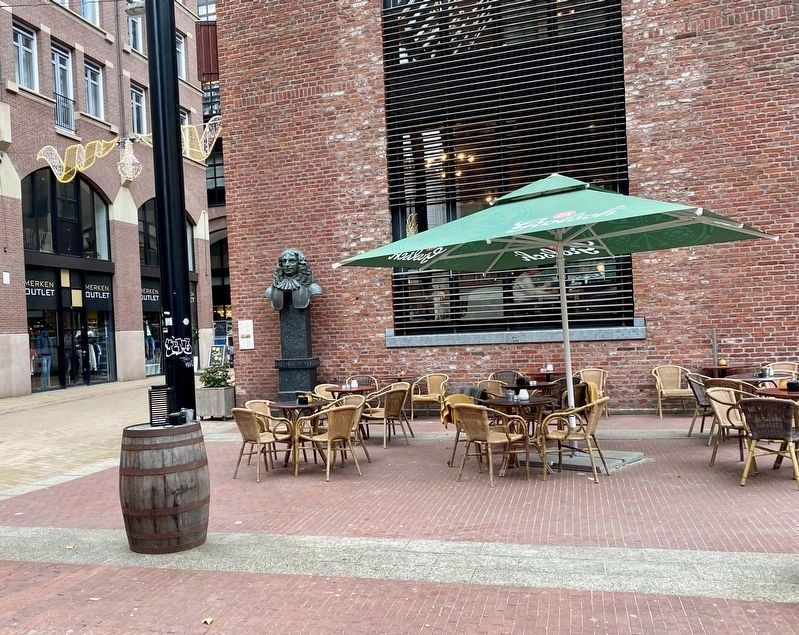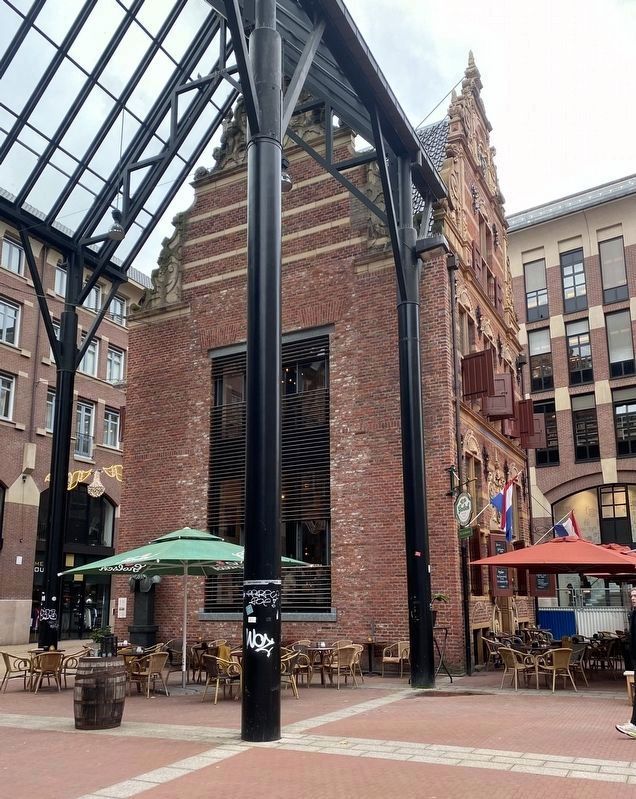Groningen, Netherlands — Northwestern Europe
Carl von Rabenhaupt
— Stadsmonumenten —
In het ‘Rampjaar’ 1672 werd Nederland aangevallen door Engeland, Frankrijk en de bisschoppen van Münster en Keulen. De vesting Groningen was voor de verdediging van Noord-Nederland van doorslaggevende betekenis. De Groningse Staten vroegen Carl von Rabenhaupt, toen al 70 jaar oud, als bevelvoerder op te treden vanwege zijn tijdens de Tachtigjarige Oorlog opgebouwde reputatie. De luitenant-generaal begon de verdediging met het onder water zetten van ongeveer een vijfde van de provincie. De Münsterse bisschop Bernhard von Galen – ‘Bommen Berend’ – en zijn Keulse collega konden de stad daardoor alleen over de Hondsrug benaderen.
Rabenhaupt had slechts de beschikking over 2000 soldaten en 1260 bewapende burgers waaronder een compagnie studenten, terwijl de belegeraars met ruim 22.000 man waren. Ondanks de ruim 4000 ‘bommen’ die op de stad werden afgevuurd, doorstonden Groningen en Rabenhaupt het beleg met succes, dankzij onder andere hun kanon ‘De Grote Griet’. Op 28 augustus was het Ontzet een feit. Het behoud van Groningen bleek van cruciale betekenis en leidde tot de spreuk: ‘Groningen constant, behoudt van het land’.
Bij de viering in 1872 stond er korte tijd een borstbeeld van de held op de Ossenmarkt. Honderd jaar later wilde een aantal Groningers een permanent beeld voor Rabenhaupt. Nadat er genoeg geld was ingezameld, ging de opdracht naar Willem Valk, die inmiddels de 70 gepasseerd was en daarmee zijn laatste van vele Groningse beelden maakte. Valk zette op de sokkel: ‘1672 Rabenhaupt verdediger van Stad en Lande’.
Er werd gekozen voor een plaats in de buurt van het stadhuis, van waaruit de verdediging van de stad werd geleid. De buste van Rabenhaupt keek uit op de Herestraat, richting de vijand. Daarna stond het beeld een periode aan de noordkant van het stadhuis. Op initiatief van de Koninklijke Vereeniging voor Volksvermaken, die de viering van Groningens Ontzet organiseert, kwam het borstbeeld terecht op de huidige plek. Het beeld maakt onderdeel uit van de jaarlijkse festiviteiten rond Groningens Ontzet op 28 augustus, een viering die is opgenomen in de Nationale Inventaris Immaterieel Cultureel Erfgoed.
(English translation:)
In the 'Disaster Year' of 1672, the Netherlands was attacked by England, France and the bishops of Münster and Cologne. The fortress of Groningen was of decisive importance for the defense of the Northern Netherlands. The Groningen States asked Carl von Rabenhaupt, then already 70 years old, to act as commander because of his reputation built up during the Eighty Years' War. The lieutenant general began the defense by flooding about one-fifth of the province. The Münster bishop Bernhard von Galen - 'Bommen Berend' - and his Cologne colleague could therefore only approach the city over the Hondsrug.
Rabenhaupt only had 2,000 soldiers and 1,260 armed civilians, including a company of students, while the besiegers numbered more than 22,000. Despite the more than 4000 'bombs' that were fired at the city, Groningen and Rabenhaupt successfully withstood the siege, thanks in part to their cannon 'De Grote Griet'. On August 28, the relief of the city was certain. The preservation of Groningen turned out to be of crucial importance and led to the saying: 'Groningen holds, the country is saved'.
At the celebration in 1872, a bust of the hero stood on the Ossenmarkt for a short time. One hundred years later, a number of Groningen residents wanted a permanent statue for Rabenhaupt. After enough money had been collected, the assignment went to Willem Valk, who was now over 70 and thus made his last of many Groningen sculptures. Valk wrote on the pedestal: '1672 Rabenhaupt defender of City and Country'.
A place was chosen near the town hall, from where the defense of the town was directed. The bust of Rabenhaupt faced the Herestraat, towards the enemy. After that, the statue stood for a period on the north side of the town hall. At the initiative of the Koninklijke Vereeniging voor Volksvermaken, which organizes the celebration of Groningen Relief, the bust ended up in its current location. The statue is part of the annual festivities around Groningens Ontzet on August 28, a celebration that is included in the National Inventory of Intangible Cultural Heritage.
Erected by Gemeente Groningen. (Marker Number 101.)
Topics and series. This historical marker is listed in these topic lists: Arts, Letters, Music • Wars, Non-US. In addition, it is included in the Groningen Stadsmonumenten series list. A significant historical date for this entry is August 28, 1672.
Location. 53° 13.107′ N, 6° 33.976′ E. Marker is in Groningen. Marker is at the intersection of Waagplein and Waagstraat, on the right when traveling west on Waagplein. Touch for map. Marker is at or near this postal address: Waagplein 1, Groningen 9712 JX, Netherlands. Touch for directions.
Other nearby markers. At least 8 other markers are within walking distance of this marker. Goudkantoor (a few steps from this marker); Chez Dicque (within shouting distance of this marker); Groningen Municipal Council Members Memorial (within shouting distance of this marker); De bevrijding van Groningen / The Liberation of Groningen Memorial (within shouting distance of this marker); De Drie Gezusters / The Three Sisters (about 120 meters away, measured in a direct line); Het Soephuis / The Soup House (about 120 meters away); Martinitoren / St. Martin Tower (about 150 meters away); Vismarkt 40 (about 180 meters away). Touch for a list and map of all markers in Groningen.
Also see . . . Carl von Rabenhaupt (Wikipedia).
Excerpt: Carl von Rabenhaupt (6 January 1602 – 12 August 1675) was a Bohemian Hussite nobleman who fought in Dutch and Hessian service during the Thirty Years War and came out of retirement to help the Dutch defend Groningen during the Franco-Dutch War. He made a name for himself as a siege specialist, taking or successfully defending many fortified cities along the Dutch-German border.(Submitted on November 29, 2022.)
Credits. This page was last revised on December 31, 2023. It was originally submitted on November 26, 2022, by Andrew Ruppenstein of Lamorinda, California. This page has been viewed 74 times since then and 13 times this year. Photos: 1, 2, 3, 4. submitted on November 26, 2022, by Andrew Ruppenstein of Lamorinda, California.



